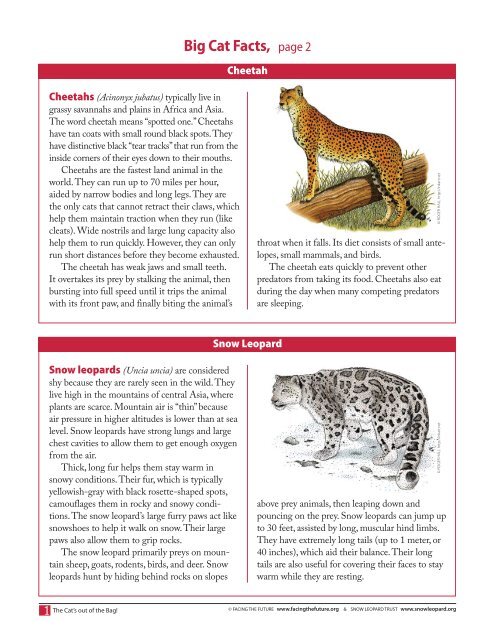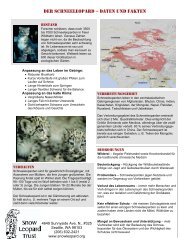Download the 7 Mb PDF file - Snow Leopard Trust
Download the 7 Mb PDF file - Snow Leopard Trust
Download the 7 Mb PDF file - Snow Leopard Trust
You also want an ePaper? Increase the reach of your titles
YUMPU automatically turns print PDFs into web optimized ePapers that Google loves.
1<br />
Cheetahs (Acinonyx jubatus) typically live in<br />
grassy savannahs and plains in Africa and Asia.<br />
The word cheetah means “spotted one.” Cheetahs<br />
have tan coats with small round black spots. They<br />
have distinctive black “tear tracks” that run from <strong>the</strong><br />
inside corners of <strong>the</strong>ir eyes down to <strong>the</strong>ir mouths.<br />
Cheetahs are <strong>the</strong> fastest land animal in <strong>the</strong><br />
world. They can run up to 70 miles per hour,<br />
aided by narrow bodies and long legs. They are<br />
<strong>the</strong> only cats that cannot retract <strong>the</strong>ir claws, which<br />
help <strong>the</strong>m maintain traction when <strong>the</strong>y run (like<br />
cleats). Wide nostrils and large lung capacity also<br />
help <strong>the</strong>m to run quickly. However, <strong>the</strong>y can only<br />
run short distances before <strong>the</strong>y become exhausted.<br />
The cheetah has weak jaws and small teeth.<br />
It overtakes its prey by stalking <strong>the</strong> animal, <strong>the</strong>n<br />
bursting into full speed until it trips <strong>the</strong> animal<br />
with its front paw, and finally biting <strong>the</strong> animal’s<br />
<strong>Snow</strong> leopards (Uncia uncia) are considered<br />
shy because <strong>the</strong>y are rarely seen in <strong>the</strong> wild. They<br />
live high in <strong>the</strong> mountains of central Asia, where<br />
plants are scarce. Mountain air is “thin” because<br />
air pressure in higher altitudes is lower than at sea<br />
level. <strong>Snow</strong> leopards have strong lungs and large<br />
chest cavities to allow <strong>the</strong>m to get enough oxygen<br />
from <strong>the</strong> air.<br />
Thick, long fur helps <strong>the</strong>m stay warm in<br />
snowy conditions. Their fur, which is typically<br />
yellowish-gray with black rosette-shaped spots,<br />
camouflages <strong>the</strong>m in rocky and snowy conditions.<br />
The snow leopard’s large furry paws act like<br />
snowshoes to help it walk on snow. Their large<br />
paws also allow <strong>the</strong>m to grip rocks.<br />
The snow leopard primarily preys on mountain<br />
sheep, goats, rodents, birds, and deer. <strong>Snow</strong><br />
leopards hunt by hiding behind rocks on slopes<br />
The Cat’s out of <strong>the</strong> Bag!<br />
Big Cat Facts, page 2<br />
Cheetah<br />
<strong>Snow</strong> <strong>Leopard</strong><br />
throat when it falls. Its diet consists of small antelopes,<br />
small mammals, and birds.<br />
The cheetah eats quickly to prevent o<strong>the</strong>r<br />
predators from taking its food. Cheetahs also eat<br />
during <strong>the</strong> day when many competing predators<br />
are sleeping.<br />
above prey animals, <strong>the</strong>n leaping down and<br />
pouncing on <strong>the</strong> prey. <strong>Snow</strong> leopards can jump up<br />
to 30 feet, assisted by long, muscular hind limbs.<br />
They have extremely long tails (up to 1 meter, or<br />
40 inches), which aid <strong>the</strong>ir balance. Their long<br />
tails are also useful for covering <strong>the</strong>ir faces to stay<br />
warm while <strong>the</strong>y are resting.<br />
© FACING THE FUTURE www.facing<strong>the</strong>future.org & SNOW LEOPARD TRUST www.snowleopard.org<br />
© ROGER HALL http://inkart.net © ROGER HALL http://inkart.net




